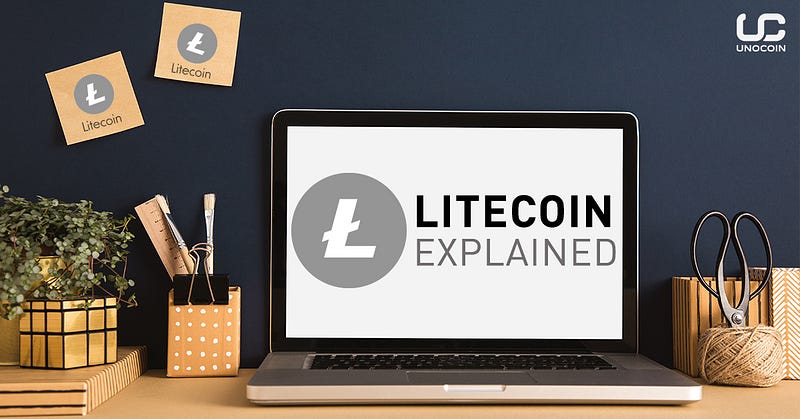
Litecoin is another crypto asset often named “digital silver”, envisioned as a counterpart to Bitcoin, which is often called “digital gold”. It is ranked among the top altcoins and is increasingly popular with the crypto asset community. Litecoin is attractive for users and investors for its robust trading volume, ease of use.
Let’s look at why Litecoin is among the top-ranked digital assets:
What is Litecoin?
Litecoin is an open-source, fully decentralized digital asset. It is attractive to users because it allows instant, near-zero cost payments all over the world. The Litecoin blockchain is an open source, fully decentralized project, developed by volunteers with plans to add full-time programmers to expand and improve the experiences of users and investors.
Litecoin is among the top offerings in most online exchanges. Exchanging Litecoin for Bitcoin is easy. Litecoin is liquid i.e.it is also relatively easy to buy and sell Litecoin for cash. The popularity of the coin is so far-reaching that there are Litecoin debit cards available along with Bitcoin debit cards. Litecoin is a suitable way to diversify crypto asset positions and mitigate the risk of fluctuations in other top crypto assets – Ethereum and Dash.
Litecoin is a non-inflationary coin. The algorithm would never allow creation of more than 84 million Litecoin, ensuring demand and the ability to store value, just like precious metals. This is Litecoin’s promise to serve as “digital silver”.
Litecoin History
The launch of Litecoin happened as a GitHub release on October 7, 2011. The name behind Litecoin is Charlie Lee, a former Google employee. Lee moved on to work with Coinbase between 2013 and 2017, but in July 2017 moved onward to continue building on Litecoin just as its popularity was rising.
The coin’s creator is not anonymous and in the near future will be personally involved with technical guidance on the coins. Lee also coined the concept of “digital silver,” as a counterpart to Bitcoin, which is sometimes called “digital gold”. Litecoin stands for silver because of the lower price, wider availability and better accessibility.
Litecoin Investment
Litecoin turned into an attractive investment position as its price rose from $45 to about $350, earlier in January 2018. Litecoin, like other digital assets, is susceptible to short-term panic or speculative sell-offs. Part of the crypto coin ecosystem includes speculative traders. The volatility of Litecoin is higher than for traditional asset classes. Compared to other altcoins, Litecoin volatility may be lower.
The current market capitalization of Litecoin is more than $3.1 billion. Litecoin value stands solidly within the top 5 crypto assets by market capitalization.
The Future of Litecoin
The future of Litecoin is considered stable due to the dedicated technological community and regular updates that increase speed and decrease cost. The Google+ following on the Litecoin project has more than 5,000 followers dedicated to maintaining the stability of the Litecoin network and expanding the Litecoin ecosystem. A newly released Litecoin Roadmap for 2017 cited 14 developers assigned to various tasks to improve the service powers of the Litecoin blockchain. Another area of focus is the release of an improved Android wallet. There has been fundraising and plans to hire full-time developers for the Litecoin Core project as well.
Users and investors may also expect the Litecoin Network project, tracking and gathering information about the blockchain to happen in one place. The site would keep a record of development, network economics, mining information and historical data.
The most notable innovation for Litecoin would be the possibility for smart contracts or conditional payments between parties. Smart contracts would make Litecoin similar in technology to Ethereum.
The other priority concern of the team and community around Litecoin is the Lightning Network, a system of fast transactions.
Litecoin SegWit
The SegWit, standing for Segregated Witness, is a technological solution to speed problems. For Litecoin, SegWit was adopted and has been operational since May 2017. SegWit is a soft fork technology that allows Litecoin transactions to move fast enough, even as the Litecoin blockchain grows bigger.
The Litecoin Segwit won over the community after some discussion. According to experts, this would open the door for technological innovation and the wider usage of the Lightning network.
Places that accept Litecoin
Litecoin users can spend this asset for an array of IT-related services. Hosting, security, even mining rigs are available for the Litecoin community. Currently, there are still limited offers on consumer goods. Litecoin is also popular with the e-commerce sector and many sites like Overstock.com, AllThingsLuxury, BTCTrip have started accepting Litecoin as a form of payment. People can easily pay for gifts, vacations, household appliances, and even precious metals and gems with their Litecoin.
Litecoin Blockchain
One Litecoin can be subdivided into millicoins (1/100 Litecoin), microcoins (1/100000 Litecoin) or Litoshis, the smallest unit, a ten-millionth part of a Litecoin. The Litecoin blockchain uses a different hashing algorithm from Bitcoin. Litecoin runs on Scrypt, a more complex calculation mode than the SHA-256 used for Bitcoin. Because the network generates new blocks more frequently, for a long time, it supported transactions without the need for software modification. Users and merchants get faster confirmation times. In the coming years, the technology is expected to improve speed and security.
Litecoin vs Bitcoin
Price
It is difficult to ignore the difference in price of the two assets as Litecoin is priced around $325 per LTC, while Bitcoin costs a whooping $16,000 per BTC. However, that shouldn’t make any difference since we can buy any multiple we want of both coins.
Mining
The key difference for end-users being the 2.5 minute time to generate a block, as opposed to bitcoin’s 10 minutes.
Transaction
The main difference is that litecoin can confirm transactions much faster than bitcoin. The implications of that are as follows:
- Litecoin can handle a higher volume of transactions as it has a faster block generation capacity. If bitcoin were to try to match this, it would require significant updates to the code that everyone on the bitcoin network is currently running.
- The faster block time of litecoin reduces the risk of double spending attacks — this is theoretical in a situation where both networks have the same hashing power.
- A merchant who waited for a minimum of two confirmations would only need to wait five minutes, whereas they would have to wait 10 minutes for just one confirmation with bitcoin.
- The maximum number of coins is, consequently, four times higher than the maximum number of Bitcoin.
Litecoin in its own ways adds value to the world of crypto assets with a market cap of more than $3.1 billion of the total market. It would be interesting to further observe the change in prices as an altcoin as this asset sees widespread adoption.
Also Read:
https://blog.unocoin.com/japanese-company-to-pay-thousands-of-its-employees-in-bitcoin-efab3ffce6a9



